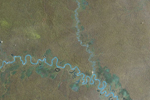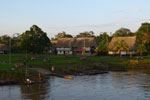Evidence of indigenous people living in “voluntary isolation” in a remote part of the Amazon has been found where an Italian Catholic priest is campaigning for Peru’s government to build a highway. The discovery is controversial because the priest has questioned the existence of the isolated people, sometimes referred to as uncontacted, who live without regular contact with anyone else.
The indigenous organization Federacion Nativa del Rio Madre de Dios y Afluentes (FENAMAD) and Peru’s Protected Areas Office (SERNANP) found the evidence during an expedition in the Madre de Dios region in July.
“We found considerable evidence that conclusively demonstrates the existence of indigenous people in voluntary isolation,” reads a FENAMAD statement released on July 30. “The area where the evidence was found coincides with the route proposed by Bill 1035 to build a highway between Puerto Esperanza and Inapari.”
According to FENAMAD’s statement, the first evidence was found in a logging concession adjacent to a reserve which was established for the isolated people in 2002. This was approximately 13 kilometers from the reserve’s eastern boundary, just six kilometers from a camp used by the loggers.
More evidence was found as the expedition moved closer to the reserve, mainly “signs of paths used by the indigenous people in voluntary isolation.” The last evidence, just six kilometers from the reserve, was a three meter-long plant stem blocking a pathway.
“That is a typical way of the isolated people saying ‘No Entry’,” says FENAMAD.
FENAMAD’s statement emphasizes the danger to the isolated groups posed not only by the highway, but the loggers operating so close to them.
“This evidence shows that their traditional territories extend beyond the boundaries of their reserve and into areas opened up to logging,” says Jorge Payaba, director of FENAMAD’s Indigenous Peoples in Voluntary Isolation Program. “We demand that forestry activities in regions adjacent to the reserve are abandoned, and that the reserve itself is enlarged to reflect the isolated peoples’ real territories.”
SERNANP, part of Peru’s Environment Ministry, published a statement on August 3 saying the expedition proved the existence of the isolated people, but the priest, F. Miguel Piovesan, who has questioned their existence, could not be reached for his reaction. Piovesan, based in Puerto Esperanza in Peru’s Purus region, has been promoting the highway in his parish magazine, on the internet, on the radio and during mass in the local church.
“FENAMAD is saying the sort of things only people who haven’t visited Purus say,” said a spokesman for Piovesan when asked about the recent findings. “The efforts to protect the uncontacted people are negatively affecting those of us who are already contacted.”
Puerto Esperanza is so remote from the rest of the country it is only accessible by plane. According to Piovesan, who is supported by some local people, the highway would significantly improve Purus’s economy.
The highway is also supported by some members of Peru’s Congress and a bill has been presented declaring it in the “national interest,” but several government ministries, including the Ministry of Transport, have come out against it.
If built, the highway would cut through Peru’s biggest national park, which is supported by the WWF, and the isolated peoples reserve, as well as indigenous communities and a communal reserve used by them.
“The evidence for the existence of isolated indigenous people in the region where there are plans to build the Purus-Inapari highway has been extensively documented,” says Jorge Herrera, from the WWF’s Peru office. “What SERNANP and FENAMAD found corroborates that.”
FENAMAD and other indigenous organizations in Peru including the Asociacion Interetnica de Desarrollo de la Selva Peruana (AIDESEP) and the Federacion de Comunidades Nativas de la Provincia de Purus (FECONAPU), as well as international organizations such as Survival International and the Upper Amazon Conservancy, have all spoken out against the highway.
In addition to the potential impact on the isolated people, it would devastate the rainforest and encourage illegal resource extraction, including logging, mining, poaching and drug trafficking, they argue.
Piovesan has ridiculed and insulted some of his opponents, and FECONAPU wants him removed from his post.
At least two isolated groups would be affected by the highway, one known as the Mashco-Piro. It would violate their rights under international law, the International Labour Organization’s Convention 169, and could lead to contact between them and other people which could decimate them because of their lack of immunological defenses.
In total, there are at least 15 isolated indigenous groups in Peru, all of them living in the most remote areas of the rainforest.
The evidence for them is abundant and has been collected over many years by indigenous organizations, international organizations, anthropologists and others.
It includes physical evidence such as food remains, gardens, abandoned fires and camps, arrows, paths and plant stems or spears blocking the way, and occasional sightings of them or encounters with them, some of which have been recorded on still or video camera.
Some media outlets and NGOs dub them “uncontacted,” however most, if not all, are believed to be the survivors of previous contact when many of them were killed or decimated by disease, but have now chosen “voluntary isolation.”

Aerial view of the Peruvian Amazon. Photo by: Rhett A. Butler.
Related articles
Peru considers big changes to its environmental reviews
(08/01/2012) The Peruvian government is looking into making large-scale changes to its Environment Impact Assessments (EIA) after a review found significant problems with the vast majority of past reviews, reports the Inter Press Service. The news comes a few weeks after protests over a proposed gold and copper mine in the Andes left five people dead, including a 17-year-old boy.
Vietnam buys stakes in controversial oil blocks threatening Peru’s most vulnerable indigenous people

(07/11/2012) Vietnam’s state oil and gas company, PetroVietnam Exploration and Production (PVEP), has announced its intention to acquire a major stake in controversial oil operations in the remote Peruvian Amazon. This area, known as Lot 67, is one of the most biodiverse in the world and home to indigenous people living without regular contact with outsiders, sometimes dubbed ‘isolated’ or ‘uncontacted’, who could be decimated by contact with oil company workers because they are highly vulnerable to disease.
Oil company Perenco endangering ‘uncontacted’ indigenous people, says Peru

(04/25/2012) The company hoping to exploit the oil deposits slated to transform Peru’s economy has been declared to be endangering the lives of indigenous people living in “voluntary isolation” by the country’s indigenous affairs department (INDEPA). Perenco, an Anglo-French company with headquarters in London and Paris, is currently seeking approval from Peru’s Energy Ministry (MEM) to develop its operations in the Loreto region in the north of the country.
Indigenous groups oppose priest pushing for road through uncontacted tribes’ land
(04/19/2012) A grassroots indigenous organization in Peru is calling for the removal of an Italian Catholic priest from the remote Amazon in response to his lobbying to build a highway through the country’s biggest national park.
U.S. gobbling illegal wood from Peru’s Amazon rainforest

(04/10/2012) The next time you buy wood, you may want to make sure it’s not from Peru. According to an in-depth new report by the Environmental Investigation Agency (EIA), the illegal logging trade is booming in the Peruvian Amazon and much of the wood is being exported to the U.S. Following the labyrinthian trail of illegal logging from the devastated forests of the Peruvian Amazon to the warehouses of the U.S., the EIA identified over 112 shipments of illegally logged cedar and big-leaf mahogany between January 2008 and May 2010. In fact, the group found that over a third (35 percent) of all the shipments of cedar and mahogany from Peru to the U.S. were from illegal sources, a percentage that is likely conservative.
Indigenous groups fight for recognition and illumination in Peru

(03/26/2012) “Shh, wait here,” Wilson told me. I ducked down behind the buttress of a large tree to wait. We had been walking through the jungle for a few hours. At first we followed a path through the undergrowth, a wet world of ferns, trunks and lianas speckled with the sunlight that made it down through the canopy and understory, but soon we simply walked along a route Wilson picked out. I had been trying to concentrate on the myriad sounds: cicadas were the background and various small birds tweeted from different points. We were listening and looking for signs that would lead us to prey—perhaps the calm whistle of a perdiz or the scent—marking of a boar—but just before Wilson became excited I had heard nothing. He stopped and said, “Red monkeys,” pointing ahead.